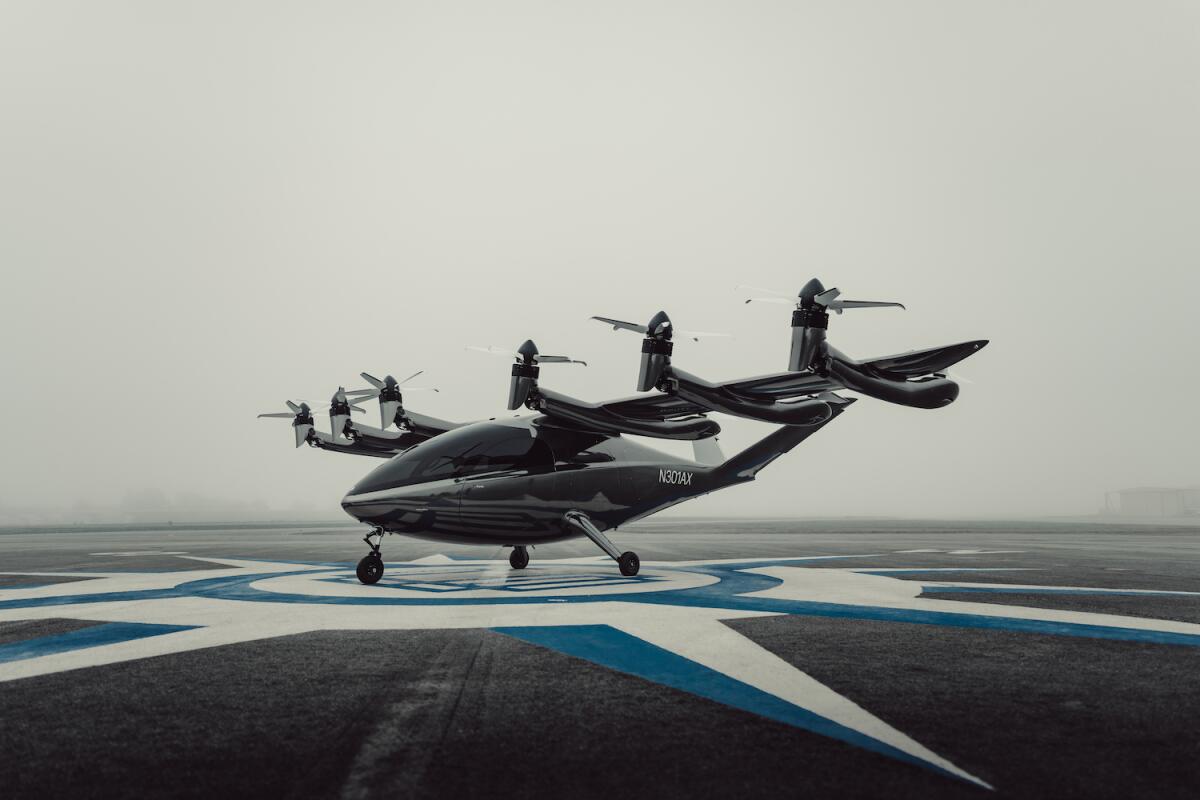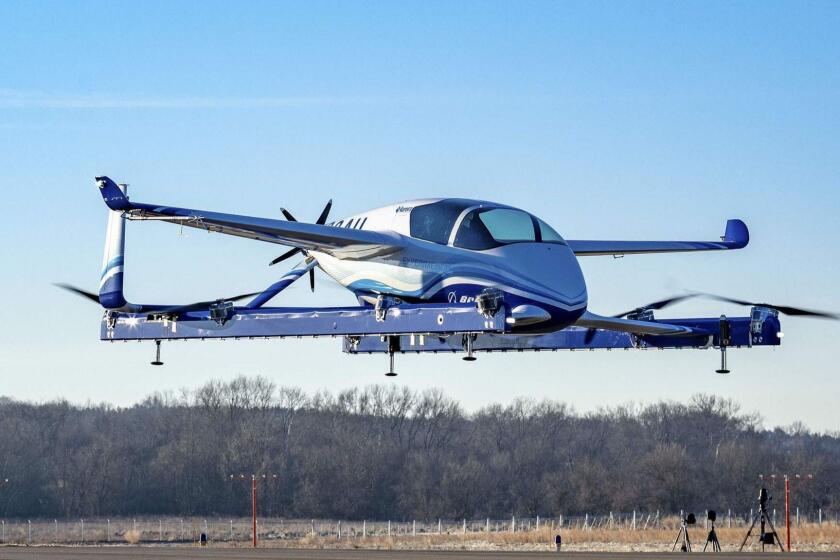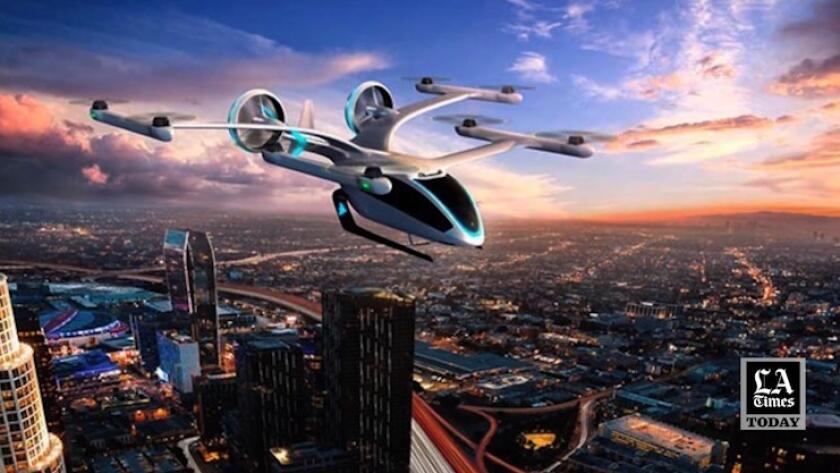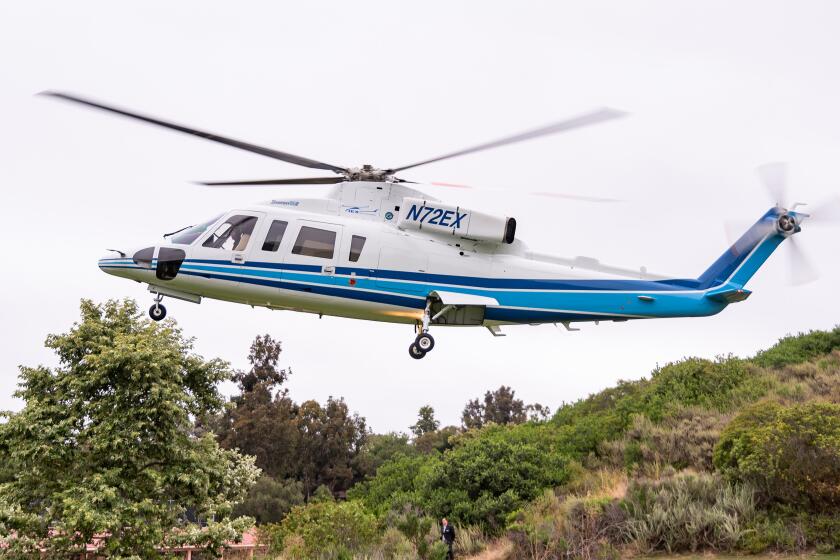Look! Up in the sky! It’s an air taxi. They’re coming to Los Angeles

- Share via
Imagine avoiding that soul-crushing, hourlong slog — say from Santa Monica to downtown L.A. on a Tuesday morning. Instead, you hail a high-tech cab that will hop over the gridlock and get you there in nine minutes.
This is Adam Goldstein’s pitch to Angelenos run ragged by traffic: air taxis.
“These vehicles just unlock something that can completely change the way we live, the way we work,” said Goldstein, the 43-year-old chief executive of Archer Aviation in Palo Alto.
The promise of flying cars — for generations a Hollywood staple of a space-age future, from “The Jetsons” to “Blade Runner” — is finally becoming a reality, so much so that a Swedish company is already selling a single-passenger vehicle called Jetson 1.
Los Angeles transportation officials are preparing for this new era and expect drone-like electric air taxis to be operational by the time the 2028 Summer Olympics roll around, if not far sooner.
Companies are eyeing L.A.’s vast inventory of parking lots and high-rise roofs for so-called vertiports as a gateway for the technology to take off internationally. Mayor Eric Garcetti has embraced the concept, and in 2019 he helped launch nonprofit Urban Movements Lab to accelerate new mobility technologies. It has been working with Archer, Hyundai and other groups to help shape city regulations around future airspace.
The city Department of Transportation released a report last year looking at the myriad potential regulations the flying taxis could face relating to noise levels, permits and how the overhead flights could affect the communities below. That followed a 2020 report with the World Economic Forum, “Principles of the Urban Sky,” outlining seven principles that should guide policy making, including noise, equity of access and connection to other transportation modes.
The efforts were a step in figuring out how to anticipate and regulate a technology that even many of its creators have not flown. There are concerns about safety, quality of life and affordability. While a single air taxi may be relatively quiet, what happens when there is a constant stream of them coming in and out of a landing spot? Should there be nighttime restrictions on flights? Will this just be a means for the ultra-wealthy to buzz over poor neighborhoods to Dodger Stadium or Crypto.com Arena?
For a booming postwar America, spilling out onto vast suburban tracts and enthralled with the possibilities of new technology, the flying car was an intriguing chimera.
In Long Beach, city officials are working with Wisk Aero, a Mountain View company, to look at how the city could integrate the technology and create economic benefits for the region. “With its rich aerospace past, current resurgence via Space Beach and its central position in the L.A. Metro area, Long Beach is an ideal city for all-electric, autonomous urban flight opportunities,” Wisk CEO Gary Gysin said in a statement in February.
Over the next two decades, entrepreneurs like Goldstein envision freeways in the sky, as air taxis follow regulated routes between popular destinations.
“You can imagine a route like LAX to Pasadena or downtown to Santa Monica,” Goldstein said. “Those will be routes where you can imagine invisible tubes in the air. These vehicles will be almost maybe like a gondola or ski lift where vehicles will be trailing each other on routes that take people 60 to 90 minutes on the ground that can be moved into the air and flown in a matter of five to 10 minutes.”
He expects a typical ride from downtown to Santa Monica to cost about $50, akin to an Uber ride.
His Silicon Valley startup is one of hundreds of companies competing to build a new American transportation empire. While many detractors doubt that such travel will soon be viable, affordable or safe, the industry is working with cities to make the technology a reality in the next five years.
These drone-like electric planes are being tested across California by heavily funded tech companies in and around Silicon Valley, including Archer, Santa Cruz-based Joby Aviation and Mountain View-based Wisk Aero. All three are looking to Los Angeles as a launchpad. The publicly traded Archer has said it aims to have commercial operations in Los Angeles by 2024.
“The industry is going to launch with a crawl, walk, run approach where there will be certain routes that will become popular,” Goldstein said. “We’ll expand to multiple routes, and then into the 2030s you’ll start to see a lot more vehicles up in the air.”
The companies are selling the idea of a quieter, cheaper alternative to helicopters to get urbanites out of traffic. Archer and Joby initially plan to launch with pilots, while Wisk is pitching an autonomous air taxi.
Archer is testing an aircraft with a 40-foot wingspan and 12 rotors. Its vehicles will zip through the air at 150 mph. One aircraft — costing $2 million — can do about 25 trips a day, averaging about 25 miles a trip.
- Share via
Watch L.A. Times Today at 7 p.m. on Spectrum News 1 on Channel 1 or live stream on the Spectrum News App. Palos Verdes Peninsula and Orange County viewers can watch on Cox Systems on channel 99.
Goldstein plans to not only run an air taxi service but sell the planes. The company has secured an agreement with United Airlines for the conditional purchase of up to $1 billion worth of the aircraft. That deal helped the electric aircraft startup go public in a deal valued at $3.8 billion.
Last year, investors poured nearly $1 billion into testing electric vertical takeoff and landing aircraft (eVTOL) companies globally, according to Pitchbook, which tracks private investment. In Paris, officials announced last year they would begin testing eVTOL for potential use along two routes that could ferry in Olympic spectators in 2024.
But though air taxis might begin limited operations soon, the sky freeways in Los Angeles that Goldstein envisions might be longer in coming, if they ever do.
Federal Aviation Administration officials have signaled that when these aircraft are certified, they can operate in much the same way that general aviation does, out of airports. That might happen in the next two years.
“We’re looking at advanced air mobility, and expecting to certify the first of those flying taxis around the 2024 timeframe,” then-FAA Administrator Steve Dickson told an aeronautic group last November.
There are multiple certifications that can take years for companies to obtain. The federal agency must approve the design, safety, manufacturing and operation of these aircraft. None of the air taxis have completed any of this.
“There’s an old kind of saying in aerospace that to certify an airplane requires like a stack of paperwork the same weight as the airplane,” said Eric Allison, product manager at Joby.
The publicly traded company received a key certification to run commercial, on-demand operations, but it still requires other approvals for design and production.
When Joby acquired Uber Elevate, Uber’s would-be air service, Joby gained access to reams of data on where people were driving to daily. Allison said it’s using that to help identify potential takeoff and landing locations, as well as where the service will be launched. It also struck a deal with a private company to find takeoff and landing sites, initially in Los Angeles, Miami, New York and San Francisco.
“We’re in conversations with lots of different people, as you might imagine,” Allison said. “Basically anyplace that has problems with congestion. I think it has a really strong possibility or probability of benefiting from this technology.”
Frustrated commuters would be the lifeblood of this industry. And there’s no shortage of them in Los Angeles.
“L.A. is like kind of that perfect location,” said Dan Dalton, an executive at competitor Wisk Aero. “It’s got a huge amount of sprawl. It’s got a huge amount of traffic, and has people who are interested in getting out of the traffic but still enjoying sprawl.”
Wisk is backed by Boeing, which invested $450 million and wants to take things a step further by going pilot-less, although it has yet to target a date or city for launch. It has been working for a decade on expanding the uses of various forms of the aircraft.
“It’s not just air taxis,” he said. “Just as many companies are also looking at cargo.
Chartered helicopters are a mode of travel few have the means to experience — and they’re in the spotlight after the crash that killed former Lakers star Kobe Bryant and eight others.
“There’s a ton of folks that are trying to move things from Santa Monica out to Van Nuys and then back down to Long Beach and doing that all day long. And in reality, at least from our perspective, that’s something that could be very easily done by aircraft that don’t necessarily need pilots.”
If the industry clears the many federal regulatory hurdles, cities must manage where these aircraft can land, and implement noise controls and safety regulations.
“It’s a very promising technology, but there’s just a number of things we need to deal with as we move along, safety and certification, noise, environmental impact, traffic management,” said Juan Alonso, an expert on eVTOL and professor of aeronautics and astronautics at Stanford University’s School of Engineering.
Alonso, who has consulted with several eVTOL companies, expects limited use of these aircraft over the next several years, including medical ambulances and cargo. He anticipates limited passenger service. But as time goes on, he thinks the cost will fall as air taxis become more widespread.
Seleta Reynolds, general manager of the Los Angeles Department of Transportation, is skeptical about freeways in the air.
“When it comes to the passenger transport, I am not yet fully convinced that the benefits outweigh the impact,” said Reynolds, who sits on an advisory committee helping to shape the FAA’s policies on air taxis.
Still, she said she’s excited about some of the technology’s potential but wants to ensure it wouldn’t exacerbate inequities by creating a traffic corridor over underserved communities already divided by land-based freeways like the 110 and 10.
“My biggest worry is that it will create a lot of impact for communities that are already impacted by the transportation system in order to benefit folks who already have a lot of choices for how they get around,” she said.
Reynolds said the idea is raising fundamental questions about the space above cities.
“Do we have a right or an expectation to be able to look up at an uncrowded sky, at a clear sky? Does that public space have a value in tangible terms of what you see in the sky? I think it’s a real important question for this industry to think about. And I don’t hear a lot of that discussion yet.”
A potentially vast expansion of aircraft over an urban area raises obvious questions about the new technology’s safety. Goldstein and others say their taxis have several propellers and battery engines, giving them a redundancy that makes them nearly fail-safe compared to helicopters. But in February, Joby’s remotely piloted prototype aircraft was “involved in an accident” during a flight test at its base in California. No one was riding in it.
The competition to be first in the air is fierce. Archer is embroiled in a legal fight with Wisk, which has accused it of taking trade secrets. The lawsuit is scheduled to go to trial next year.
All of those problems seemed far from Goldstein’s mind when he unveiled his prototype at the Hawthorne Airport last year.
In a hangar, at the midcentury airfield built for aviation pioneer Jack Northrop seven decades ago, Goldstein and his co-founder, Brett Adcock, unveiled their version of the future: a sleek two-seat demo plane with gull-wing doors and no flight controls called the Maker. The flashy demonstration, replete with a drum-playing introduction and a simulated flight over beaches and lakes, felt part Ted Talk, part Silicon Valley pitch meeting.
“We are now on the cusp of a new golden age of aviation, something that we haven’t seen in 100 years,” Goldstein told the crowd. On the stage, he slid into the Maker next to Adcock. When the company’s first air taxis take to the sky, they will have a pilot, but the autonomous Maker is where the company wants to go.
Behind him, a screen simulated what a flight would look like. The two took off from a virtual launchpad over California landscapes of snow-capped mountains and pristine deserts.
“Just looking out the window and just the perspective that you get as you fly over at all,” he said. “It makes traveling fun.”
More to Read
Sign up for Essential California
The most important California stories and recommendations in your inbox every morning.
You may occasionally receive promotional content from the Los Angeles Times.














